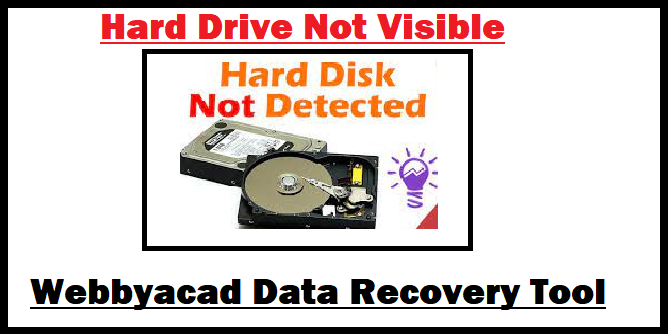In conclusion, this solution hard drive not visible problems with SD cards, USB drives, HDDs, and SSDs. in order for computers to detect, recognize, read, display, and operate on your hard drives once more.
First, determine the type of disk problem you’re having. The hard drive does not show.
If your external or internal hard drive not visible, it means that it is not accessible from any part of your computer. To put it another way, the operating system never recognizes or reads the drive. As a result, it will not be visible in File Explorer, Disk Management, Device Manager (for Windows), Finder, Disk Utility, the desktop, or even system information (for Mac).
If the disk is not visible, try the following quick fixes:
- Change the USB cable or port into which the external hard disk is plugged.
- Reconnect the drive and restart your computer.
- Attempt to access this hard drive on a separate Mac or PC.
- Failure to connect the hard drive
If the drive is not mounting, try the following solutions:
- Reconnect the hard drive to the computer.
- To repair the hard drive, use the provided disk repair tool.
- This hard drive should be reformatted and the data recovered.
- Next, determine which disk isn’t working.
- The USB drive does not show.
However, if the USB port is not working properly and the identification process is not going smoothly, the hard drive not visible. It may not function correctly if it is identified. After that, the USB cable, USB adapter, or USB port can be replaced. Alternatively, you can find comprehensive solutions in the following posts.
How can the data on non-functional hard drives be recovered?
Probably every possible solution has been attempted when your hard drive appears but is unrecognized. The disk is simply malfunctioning. Thereafter, data recovery from the hard drive becomes feasible. Webbyacad data recovery tool is compatible with both Mac and Windows computers and can be utilized to recover files from the hard drive.
Restore your hard drive by adhering to these steps:
- Download and install Webbyacad data recovery tool on your personal computer. The software operates on Windows 11/10/8/7/Vista/XP and macOS 12 through OS X 10.9.
- Connect the faulty hard drive to the computer and select it from the disk selection. Prior to proceeding, it is imperative to select a recovery module compatible with the Windows version. These modules consist of RAW, BitLocker, and data recovery.
- Click Scan to initiate a disk search for corruption data. You may terminate the scanning immediately if the missing files have been located, or you may wait for the scan to complete.
- Navigate to the identified files, select the ones that require recovery, and click the Recover button. The recovery process will require you to choose a location for the files. Remember to not save the files to the original hard drive.
Back up data
- Simple solutions to the dilemma of a hard drive not being visible
- Analyze the cable and connection interface of the hard drive.
- Verify that neither the internal nor external hard drives are detected, and assess whether the USB interface is soiled or deformed.
- In the event that the USB flash drive remains invisible, verify that the USB port is operational and compatible with an alternative port.
- Verify the SD card reader is current and in good condition if the SD card fails to load.
- Verify that the SATA, M.2, or PCI-E connection is stable and compatible if the SSD is not visible.
- System restart for Mac or Windows.
Restarting the computer effectively eliminates numerous disk issues by clearing the Random Access Memory (RAM). After the functioning background process has completed its task of clearing temporary caches and logs, the computer will distinguish the newly detected hard drive from the previously connected storage device in order to identify it.
- In a secure Escaping the hard drive of the device.
- Restart your Mac or PC after being inactive for several minutes.
- Attempt to validate the hard drive’s identification and recognition status by reconnecting it to the port.
- Confirm that the hard drive is visible in another location.
- Drive examination in Finder.
- Implement Disk Utility for a hard drive inspection.
- Verify the hard drive by navigating to System Information.
- A drive letter will be assigned by Windows to hard disks that have been detected. Disk examination in Device Manager.
- Hard device examination using Disk Management.
- Incorrectly detect the hard drive; rectify the corruption.
If the hard drive is not Visible in File Explorer on this computer, the following locations may contain it:
While it is possible for a hard disk to be detected, it is considered corrupted if its identification is not possible using the appropriate file system, storage capacity, or mount point. You must utilize the inbuilt utility on the computer in order to repair the hard drive.
- Utilize CHKDSK to repair a corrupted hard drive in Windows.
- By utilizing First Aid for Mac, one can rectify a hard disk corruption.
- Reformat the hard drive in order to restore its functionality.
When a USB drive, such as a thumb drive, is inserted into a computer’s USB port, the computer detects that a USB storage device is attempting to connect. When it has read and identified the manufacturer, device type, storage capacity, partition information, and file system, you will be able to view and access the USB drive.
In the event that disc recognition cannot be restored via the integrated disk repair program, hard drive not visible. However, prior to performing hard drive data recovery, you must perform data recovery from the hard drive, as reformatting would eliminate and cleanse all of its contents.
Read some more blogs:
Comprehensive Solutions for the Unmountable Boot Volume Issue


[…] To Fix a Hard Drive Not Visible | How-To | […]